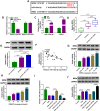Circ-OSBPL2 Contributes to Smoke-Related Chronic Obstructive Pulmonary Disease by Targeting miR-193a-5p/BRD4 Axis
- PMID: 33854310
- PMCID: PMC8039023
- DOI: 10.2147/COPD.S298465
Circ-OSBPL2 Contributes to Smoke-Related Chronic Obstructive Pulmonary Disease by Targeting miR-193a-5p/BRD4 Axis
Abstract
Background: Circular RNAs (circRNAs) have been identified to play roles in the respiratory diseases. Here, this study aimed to elucidate the function of circRNA oxysterol binding protein like 2 (circOSBPL2) in the development of smoke-related chronic obstructive pulmonary diseases (COPD).
Methods: The expression of circ-OSBPL2, microRNA (miR)-193a-5p, and bromodomain-containing protein 4 (BRD4) was detected using qRT-PCR and Western blot assays. Cigarette smoke extract (CSE)-induced human bronchial epithelial cells (HBECs) was applied to mimic smoke-related COPD in vitro. Flow cytometric analysis of cell apoptosis and ELISA analysis of interleukins (IL)-6, IL-8, tumor necrosis factor-α (TNF-α) levels were performed. The malondialdehyde (MDA) and superoxide dismutase (SOD) production levels were analyzed according to the kit instructions. The binding interaction between miR-193a-5p and circ-OSBPL2 or BRD4 was confirmed by dual-luciferase reporter assay and RNA immunoprecipitation assays.
Results: Circ-OSBPL2 was highly expressed in lung tissues of smokers without or with COPD, particularly in smokers with COPD. Also, the expression of circ-OSBPL2 was dose and time-dependently elevated in CSE-induced HBECs. Circ-OSBPL2 down-regulation in HBECs attenuated CSE-evoked cell proliferation arrest, and cell apoptosis, inflammation and oxidative stress promotion. Mechanistically, circ-OSBPL2 served as a sponge for miR-193a-5p, and miR-193a-5p inhibition reversed the effects of circ-OSBPL2 knockdown on CSE-mediated HBECs. Besides that, miR-193a-5p directly targeted BRD4, and miR-193a-5p re-expression in HBECs abolished CSE-induced HBEC injury, which was reverted by BRD4 up-regulation. Additionally, we also found circ-OSBPL2 could indirectly regulate BRD4 via miR-193a-5p.
Conclusion: Circ-OSBPL2 contributed to the apoptosis, inflammation, and oxidative stress of HBECs in smoke-related COPD by miR-193a-5p/BRD4 axis, suggesting a novel insight on the pathogenesis of COPD and a potential therapeutic strategy for future clinic intervention in COPD.
Keywords: BRD4; COPD; circ-OSBPL2; miR-193a-5p.
© 2021 Zheng et al.
Conflict of interest statement
The authors declare that they have no competing interests.
Figures








Similar articles
-
Circular RNA 0000157 depletion protects human bronchial epithelioid cells from cigarette smoke extract-induced human bronchial epithelioid cell injury through the microRNA-149-5p/bromodomain containing 4 pathway.Hum Exp Toxicol. 2023 Jan-Dec;42:9603271231167581. doi: 10.1177/09603271231167581. Hum Exp Toxicol. 2023. PMID: 37533154
-
CircANKRD11 Knockdown Protects HPMECs from Cigarette Smoke Extract-Induced Injury by Regulating miR-145-5p/BRD4 Axis.Int J Chron Obstruct Pulmon Dis. 2021 Apr 1;16:887-899. doi: 10.2147/COPD.S300332. eCollection 2021. Int J Chron Obstruct Pulmon Dis. 2021. PMID: 33833509 Free PMC article.
-
Circ-RBMS1 Knockdown Alleviates CSE-Induced Apoptosis, Inflammation and Oxidative Stress via Up-Regulating FBXO11 Through miR-197-3p in 16HBE Cells.Int J Chron Obstruct Pulmon Dis. 2021 Jul 16;16:2105-2118. doi: 10.2147/COPD.S311222. eCollection 2021. Int J Chron Obstruct Pulmon Dis. 2021. PMID: 34295155 Free PMC article.
-
Circ-CSPP1 knockdown suppresses hepatocellular carcinoma progression through miR-493-5p releasing-mediated HMGB1 downregulation.Cell Signal. 2021 Oct;86:110065. doi: 10.1016/j.cellsig.2021.110065. Epub 2021 Jun 26. Cell Signal. 2021. PMID: 34182091 Review.
-
CircRNA-associated ceRNA networks (circCeNETs) in chronic obstructive pulmonary disease (COPD).Life Sci. 2024 Jul 15;349:122715. doi: 10.1016/j.lfs.2024.122715. Epub 2024 May 11. Life Sci. 2024. PMID: 38740326 Review.
Cited by
-
Integrative analysis of the expression profiles of whole coding and non-coding RNA transcriptomes and construction of the competing endogenous RNA networks for chronic obstructive pulmonary disease.Front Genet. 2023 Jan 30;14:1050783. doi: 10.3389/fgene.2023.1050783. eCollection 2023. Front Genet. 2023. PMID: 36793900 Free PMC article.
-
Circular RNAs in human diseases.MedComm (2020). 2024 Sep 4;5(9):e699. doi: 10.1002/mco2.699. eCollection 2024 Sep. MedComm (2020). 2024. PMID: 39239069 Free PMC article. Review.
-
Roles of noncoding RNAs in chronic obstructive pulmonary disease.J Transl Int Med. 2023 Jul 5;11(2):106-110. doi: 10.2478/jtim-2023-0084. eCollection 2023 Jun. J Transl Int Med. 2023. PMID: 38025954 Free PMC article. No abstract available.
-
Diagnostic value of miR-193a-5p in severe pneumonia and its correlation with prognosis.J Cardiothorac Surg. 2025 Jan 23;20(1):87. doi: 10.1186/s13019-024-03256-y. J Cardiothorac Surg. 2025. PMID: 39849492 Free PMC article.
-
Circular RNAs: Novel Players in the Oxidative Stress-Mediated Pathologies, Biomarkers, and Therapeutic Targets.Oxid Med Cell Longev. 2021 Jun 23;2021:6634601. doi: 10.1155/2021/6634601. eCollection 2021. Oxid Med Cell Longev. 2021. PMID: 34257814 Free PMC article. Review.
References
MeSH terms
Substances
LinkOut - more resources
Full Text Sources
Other Literature Sources
Medical
Molecular Biology Databases

